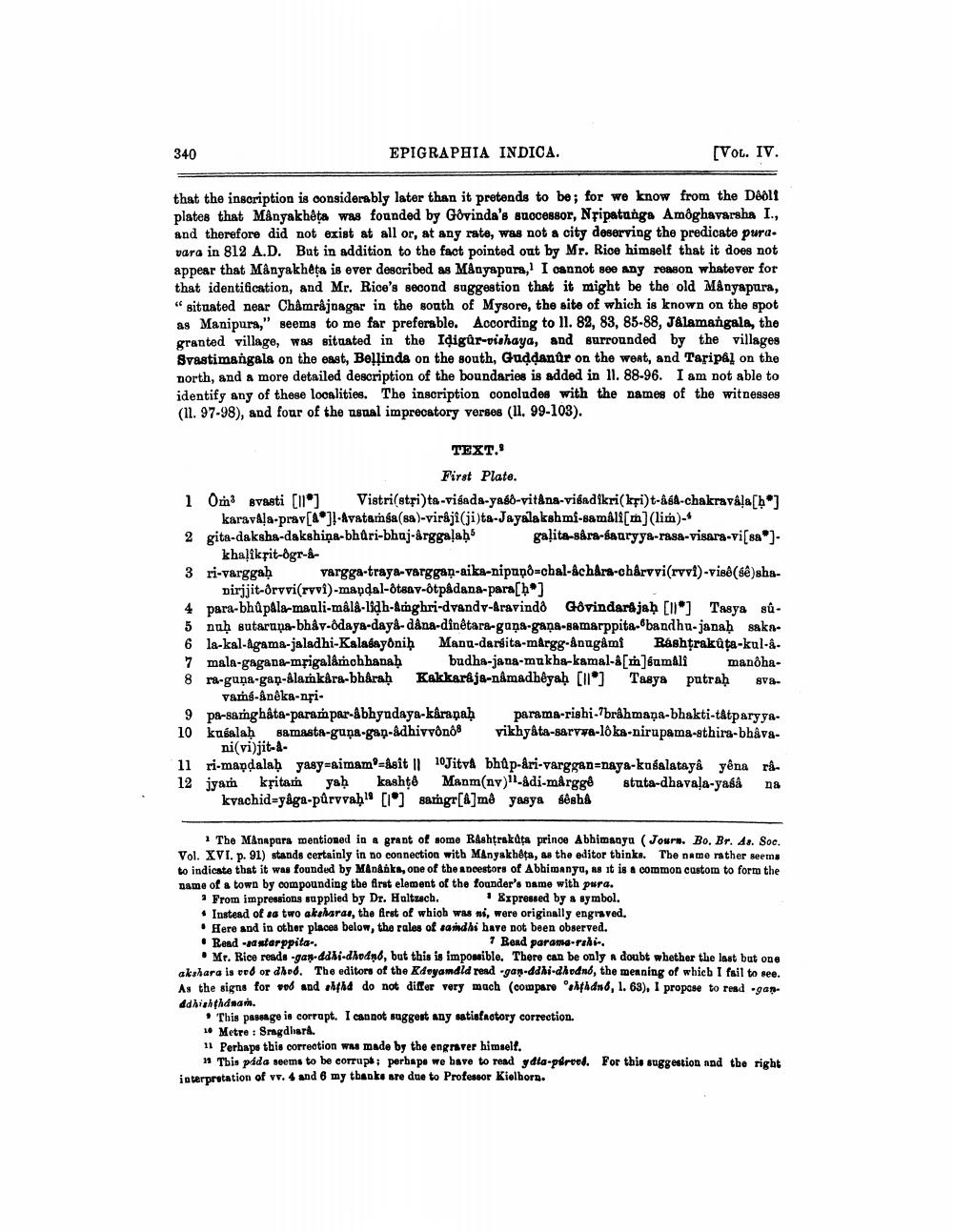________________
340
EPIGRAPHIA INDICA.
[Vol. IV.
that the inscription is considerably later than it pretends to be; for we know from the D&olt plates that Manyakheta was founded by Govinda's successor, Nfipatanga Amôghavarsha I., and therefore did not exist at all or, at any rate, was not a city deserving the predicate puravara in 812 A.D. But in addition to the fact pointed out by Mr. Rice himself that it does not appear that Månyakheta is ever described as Minyapura, I cannot see any reason whatever for that identification, and Mr. Rice's second suggestion that it might be the old Manyapura, “situated near Chamrajnagar in the south of Mysore, the site of which is known on the spot as Manipura," seems to me far preferable. According to 11. 82, 83, 85-88, Jalamangala, the granted village, was situated in the Idigûr-vishaya, and surrounded by the villages Svastimangala on the east, Bellinda on the south, Guddanur on the went, and Tarip&l on the Dorth, and a more detailed description of the boundaries is added in 11. 88-96. I am not able to identify any of these looalities. The inscription concludes with the names of the witnesses (11. 97-98), and four of the asnal imprecatory verses (11. 99-103).
TEXT.
First Plate. 1 Om svasti (11] Vistri(strita-visada-yagð-vitna-visadikri(kļi)t-âsa-chakravala[ho]
karava!a-prav[4®]!-Avatamsa(sa)-viraji(i)ta-Jayalakshmi-samáli[m] (lim)-4 2 gita-daksha-dakshiņa-bhüri-bhaj-årggaļaḥ galita-såra-sauryya-rasa-visara-vi[sa]
khalikpit-ogr-&3 ri-varggah vargga-traya-varggan-aika-nipuņo=chal-&chara-chårvvi(rvvt)-visd(se)shs
virjjit-Orvvi(rvvi)-mapdal-ôtsav-ôtpådana-para[bo] 4 para-bhûpala-mauli-mala-lidh-Amghri-dvandv-Aravindo Govindarajaḥ (11") Tasya sů. 5 nuḥ sutaruņa-bhav-ôdaya-day&- dåna-dinetara-gana-gana-samarppita-bandhu-janaḥ saka6 la-kal-Agama-jaladhi-Kalalayonih Manu-darsita-margg-anugámi Rashtrakata-kul-e7 mala-gagana-mrigalámohhanaḥ budha-jana-mukha-kamal-a[m]bumali manôha8 ra-guna-gan-alankára-bhåraḥ Kakkarája-nåmadhêyah [118] Tasya putraḥ Sva.
vams-åneka-nfi. 9 A-saringhâta-parampar-Abhyudaya-karaṇaḥ parama-rishi-brahmana-bhakti-tatparyya10 kulalah samasta-guna-gan-&dhivyono vikhyata-sarvya-loka-nirupama-sthira-bhava
ni(vi)jit-d11 ri-mapdalah yasy-aimamo=&sit II 10Jitvå bhup-åri-varggan=naya-kusalatayê yêna rå12 jyam kitam yah kashte Manm(nv)"-di-märgge stata-dhavala-yaga na
kvachid=yåga-půrvvaḥ [1] samgr[&]md yasya sesha
1 The Manapara mentioned in a grant of some Rashtrakūta prince Abhimanyu (Jours. Bo. Br. As. Soc. Vol. XVI. p. 91) stands certainly in no connection with Manyakhêţa, as the editor thinks. The name rather seems to indicate that it was founded by Mandika, one of the ancestors of Abhimanyu, as it is a common custom to form the name of a town by compounding the first element of the founder's dame with pura.
· From impressions supplied by Dr. Haltzech. Expressed by a symbol. • Instead of sa two akaharas, the first of which was ni, were originally engraved. . Here and in other places below, the rales of sandhi have not been observed. • Read - starppita..
7 Read parama-rahi. . Mr. Rice reads -gandami-dhodno, but this is impossible. There can be only a doubt whether the last but one akshara is ved or dhod. The editors of the Kdoyandld read .gam-ddhi-dhodné, the meaning of which I fail to see. As the signs for ved and thd do not differ very mach (compare ahthdno, 1. 63), I propose to read -ganddhishthaan.
. This passage is corrupt. I cannot suggest any satisfactory correction. 10 Metre : Sragdhara. 11 Perhaps this correction was made by the engraver himself.
1 Tbis pada seems to be corrupa; perhape we have to read ydia-parted. For this suggestion nnd the right interpretation of v. 4 and 6 my thanks are due to Professor Kielhorn.




